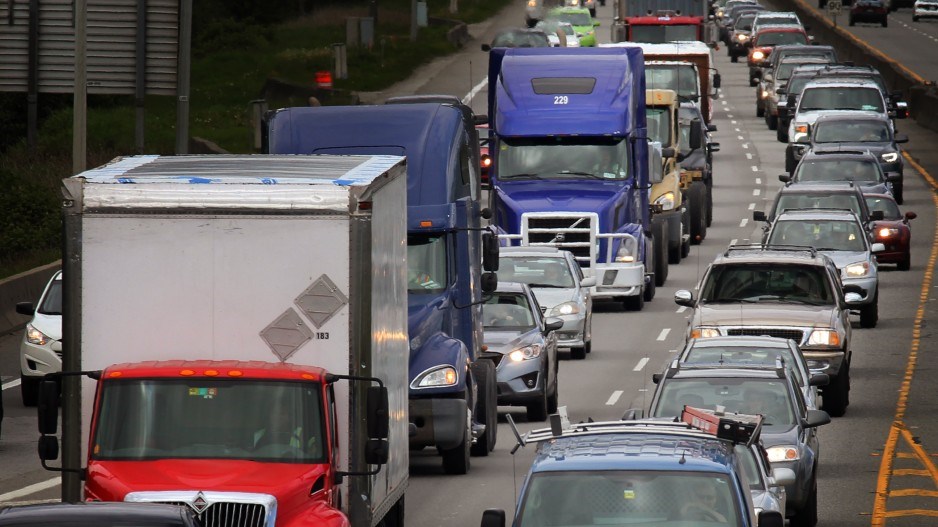Metro Vancouver mayors are looking to capitalize on federal election campaign commitments with a campaign of their own.
Their message is simple: the federal government should give municipalities and regions stable, predictable funding to support long-term transportation planning.
“What we’re looking for is something that we can count on – that 10 years in the future, we know that that funding is going to be available,” said New Westminster Mayor Jonathan Coté, chair of TransLink’s Mayors’ Council.
The council recently launched the second phase of its Cure Congestion campaign, which asks Canada’s three main political parties to commit to regular funding for transportation projects.
Eight delegates – including six mayors, the council’s executive director and TransLink CEO Kevin Desmond – spent $15,000 to bring their pitch directly to Ottawa, where the message was well received, Coté said.
The region isn’t asking for more money – Coté argues $375 million per year beginning in 2028 is in line with previous federal funding commitments.
The difference is that funding is typically allotted on a per-project basis – a model that has resulted in local municipalities jockeying for priority in a long queue of initiatives. The government’s last major contribution came last year, with a $2 billion commitment to help fund the second phase of TransLink’s 10-year vision, now fully funded through to 2027.
“We’re well aware that after that date, that funding comes to an end,” he said. “And if it is not replaced, that means that investments in transportation will grind to a halt.”
However, more money for transportation options won’t necessarily cure congestion.
“I actually get very skeptical when people claim that traffic congestion is a severe problem. I think traffic congestion is to motorists what the tide is to a sailor,” said Todd Litman, founder and executive director of the Victoria Transport Policy Institute, an independent transportation research organization.
“The real key is that traffic congestion tends to maintain equilibrium, which means it gets bad enough that it discourages some potential peak-period car trips.”
Litman called efficient road pricing “the single most effective” way to address congestion. When faced with a fee of a certain price, enough commuters will opt for an alternative mode of transportation, clearing up roadways for those willing to pay for decongested driving.
It also doubles as a revenue stream that could be used to fund those alternative transportation options.
Mobility pricing is, however, a politically sensitive issue. While it is a proven method for reducing congestion, the regional Mobility Pricing Independent Commission (MPIC) noted in its Metro Vancouver Mobility Pricing Study that it probably isn’t the way forward for a region looking, above all, to cover the costs of transportation investments, which is at the core of the region’s Cure Congestion pitch.
“That’s a huge entrenched issue,” said Peter Hall, professor of urban studies and geography at Simon Fraser University. “Municipalities and regional districts that are asked to deliver these services, they have limited revenue-raising powers and so it’s very difficult for them to secure stable funding.”
Even with a Millennium Line extension, light-rail transit in Surrey, 30% additional transit service and a 10-lane George Massey Crossing bridge, the MPIC’s report estimates the time drivers spend in congested traffic will increase by 40% by 2030.
That’s an additional 4.2 million minutes spent in traffic a day over 2016 levels, fuelled by population and job growth, and exacerbated by up to 600,000 additional cars on Metro Vancouver roads. Like road pricing, more time idling could also push people to seek out alternatives, but those alternatives need capacity.
“We don’t want to underbuild. We’ve done that too often. We did that with the Canada Line and it was full within two months,” said former B.C. premier Mike Harcourt.
Along with Mauro Chiesa, a retired World Bank financier, Harcourt says the transportation system Metro Vancouver needs would cost close to $10 billion.
Their proposal includes an express line from Willingdon to the University of British Columbia and co-ordinated bus services that connect different municipalities. Their argument is for additional capacity, and a system that is more regionally focused and interconnective, rather than a radial system that brings people to and from downtown Vancouver.
“It’s bold, it’s big, it’s costly – but it’s effective,” said Harcourt. “We’re saying let’s finally do it right and build for a hundred years, like we did with the Cleveland Dam and Stanley Park.”
Federal and provincial funding, private-sector investment and a loonie toll on the region’s 25 bridges would fund the network expansion. Chiesa said such a toll program would bring in around $800 million a year. It could also eliminate the region’s fuel tax, which generated nearly $374 million for TransLink in 2017.




